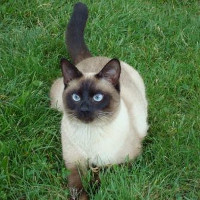In their homeland, Siamois cats were revered as temple guardians. When a high-ranking person died, his or her soul was reincarnated in the body of a cat. These cats were then sent to the temples to live out their days in luxury and opulence (fine food on gold plates). They could then have a certain power and intercede for the soul of the deceased.
Legend has it that the Siamois had a slight squint in its early days, as it fiercely guarded Siam's royal treasures and stared at them so intently that it squinted. Legend also has it that the Siamois tail has a knot or break in it. This is because royal princesses used to hang their rings around the cat's tail so as not to lose them while bathing. Truth or legend, today's cats are not allowed to show any squint or tail defect in cat shows. Although tolerated in the old breed standards, these deformities are now disqualifying.
In fact, the first known Siamois cats were imported from the Kingdom of Siam and exhibited at London's Crystal Palace in 1871. The Wichien-maat, as it is known in Thailand, was a public craze from the early 20th century until the Second World War.
By the 1960s, silhouettes had become more refined through selection, leaving behind the traditional Siamois and giving rise to the slender shapes we know today. The original morphology has nevertheless been perpetuated, retaining the qualities and appearance of the old-style Siamois. The name Siamois has remained, and is now anchored to the new, slender, lanky forms. It was therefore necessary to find a name for the old Siamois, with its rounder, stockier appearance. The name Thai was chosen, as the breed originated in Siam, now known as Thailand (Land of the Thais).
The breed clubs in France, affiliated to the LOOF, are EuroThaï and the Thaï Féline Club. The clubs are involved in drawing up the LOOF standard. |
| The character of the Thaï is described as identical to that of the Siamois. They are what we call “cat-dogs”. Very affectionate and present, the Thaï, as ancestor of the Siamois, is said to be quite expressive and talkative, knowing how to make himself understood in any situation. However, these character traits are entirely individual and depend above all on the history of each cat. |

 In France, no interbreeding is allowed.
In France, no interbreeding is allowed. TICA, on the other hand, allows Siamois.
TICA, on the other hand, allows Siamois.





 English (United Kingdom)
English (United Kingdom)